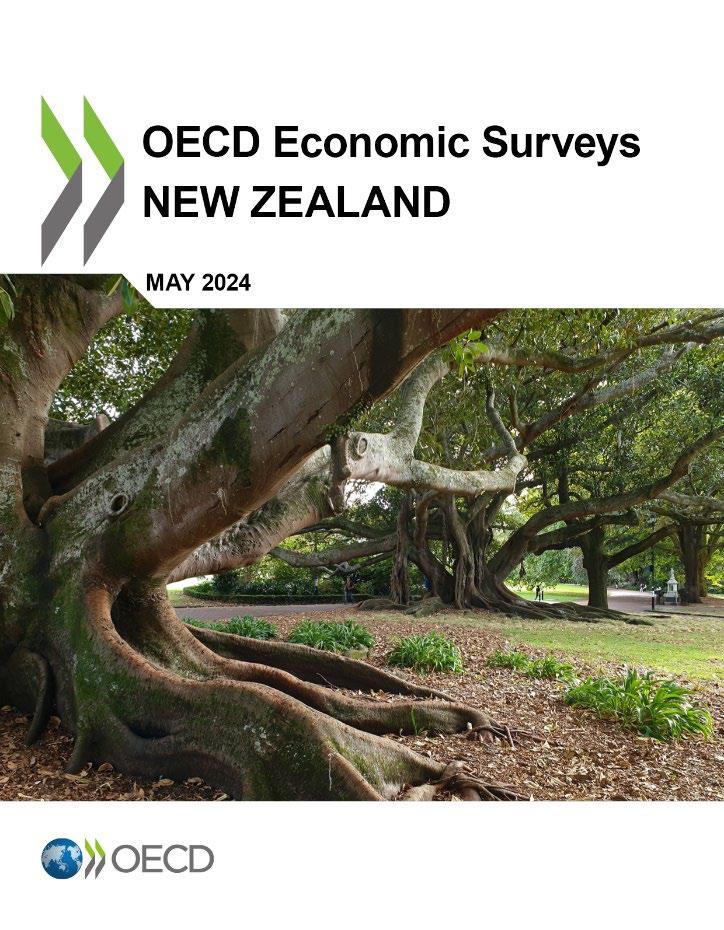




OECD ECONOMIC SURVEY OF NEW ZEALAND Rebalancing towards more sustainable growth @OECD @OECDeconomy Wellington 6 MAY 2024 oe.cd/new-zealand

The economy has weathered a difficult period
Source:
2
OECD Economic
database. Real GDP -15 -10 -5 0 5 10 15 20 2020 2021 2022 2023 New Zealand OECD Year-on-year % growth
Outlook

Tourist entries are approaching pre-COVID-19 levels 3
Monthly arrivals of overseas visitors 0 50 100 150 200 250 300 350 400 2018 2019 2020 2021 2022 2023 2024 Thousands, seasonally adjusted
Source: Statistics New Zealand.

The current account deficit is high though it has declined 4 Source: OECD, Balance of Payments (database). Current account balance -15 -10 -5 0 5 10 15 20 25 30 GRC CHL NZL TUR USA GBR POL FIN FRA ITA MEX BEL OECD CAN AUT ESP AUS KOR JPN ISR DEU SWE NLD CHE NOR
%
2022 Average, 2012-2022 Year ended January 2024
of GDP

Growth is projected to pick up slowly
Annual growth rates in % unless noted
Source: OECD Economic Outlook Database.
Real GDP 2023 2024 0.8 1.9 2025 5.7 Consumer price index 2.4 3.2 Unemployment rate (% of labour force) 3.7 4.8 4.7 0.6
5

Restoring macroeconomic balance

6

Monetary policy should remain restrictive until inflation nears the target
The labour market is slowly softening
%, seasonally adjusted Million, seasonally adjusted
Unemployment rate (left hand side)
Labour cost index (year-on-year %-changes, left hand side)
Employment (right hand side)
7 Source: Statistics New Zealand. 0 1 2 3 4 5 6 7 8 2016 2018 2020 2022 2024 Core inflation has eased Ordinary time hourly wages, private sector Core consumer price index Year-on-year %-changes 2.6 2.7 2.8 2.9 3.0 3.1 3.2 0 1 2 3 4 5 6 7 2018 2019 2020 2021 2022 2023

Steadily reducing the fiscal deficit will help rebalance the economy and prepare for future shocks 8 Note: Gross debt refers to general government gross financial liabilities. Net debt refers to gross debt minus general government gross financial assets. Source: OECD, Economic Outlook (database). 0 10 20 30 40 50 60 70 2014 2016 2018 2020 2022 2024 Public debt Net debt Gross debt % of GDP % of GDP -10 -8 -6 -4 -2 0 2 4 6 8 30 32 34 36 38 40 42 44 46 48 50 2014 2016 2018 2020 2022 2024 Government finances Total spending (left hand side) Total revenue (left hand side) Net lending (right hand side) % of GDP

Inward migration policy should align with labour market needs and be accompanied by public service provision
Inflow of foreign migrants as a share of the population
Average, 2010-2019 Rolling year ended December 2023
Source: OECD, International Migration Database and Statistics New Zealand.
9
0.0 0.5 1.0 1.5 2.0 2.5 3.0 3.5 4.0 4.5 MEX SVK POL LVA ISR JPN HUN FRA USA CZE EST FIN GRC ITA PRT GBR SVN CHL KOR DNK CAN ESP AUS NLD IRL BEL SWE NOR DEU AUT CHE ISL NZL LUX
%

Boosting competition

10

Regulatory reform would improve productivity
Economy-wide product market regulation indicators 2018, Index from 0 (most) to 6 (least competition friendly)
New Zealand OECD average
5 Most competition-friendly countries
5 Least competition-friendly countries
Involvement in business operations Regulations impact evaluation Admin. and regulatory burden Barriers in service and network sectors Barriers to trade and investment
Note: All the averages include only OECD countries. Refers to laws and regulation in force on 1 January 2018. Indicators of product market regulation for 2023 will be published later this year.
Source: OECD 2018 PMR database.
11
0.0 0.5 1.0 1.5 2.0 2.5 3.0 3.5 4.0 Public ownership

Reducing barriers would help increase foreign direct investment into New Zealand
% of GDP
Foreign direct investment position, 2022¹ (left hand side)
Foreign direct investment restrictiveness, 2020 (right hand side)
1. 2021 values for Australia, Belgium, Denmark, Finland, Greece, Korea, Latvia and Norway.
Source: OECD (2023), Foreign Direct Investment Statistics.
12
0 0.04 0.08 0.12 0.16 0.2 0.24 0.28 0 20 40 60 80 100 120 140 JPN KOR GRC TUR ITA DEU FIN ISL FRA SVN NOR DNK NZL POL USA AUS AUT ISR MEX LTU SVK ESP HUN LVA SWE COL CAN CZE PRT CRI CHL GBR BEL EST CHE
Index

A range of tools is needed to enhance competition
Selected product market regulation components and subcomponents for New Zealand, index from 0 (most) to 6 (least competition friendly)
Distortions induced by public ownership
Quality and scope of public ownership
Governance of commercial state-owned enterprises
Administrative and regulatory burden
Administrative requirements for small companies
Communication and simplification of administrative and regulatory burden
Interaction with stakeholders
Involvement of all stakeholders
Involvement of interest groups
Barriers to trade and investment
Barriers to foreign direct investment
Barriers to trade facilitation
13 Source: OECD 2023 Product Market Regulation indicators for New Zealand.
0 1 2 3 4 5 6
2023
Index
2018

Retaining market studies to identify competition issues
example in banking 14 Source: Reserve Bank of New Zealand.
2000-2021 0 5 10 15 20 25 PRT DEU JPN ITA CHE NLD AUT FRA GBR BEL DNK FIN ISR SGP USA CAN NOR AUS HKG SWE NZL %
and solutions by sector, for
Pre-tax return for banks on equity across selected countries,

The Commerce Commission should be given better tools to ensure digital market competition, including for mobile phone data usage
Share of fibre connection in total fixed broadband, 2022
Monthly data usage per mobile broadband subscription, 2022
GB per month
Source: OECD, Broadband Portal, http://www.oecd.org/digital/broadband/broadband-statistics.
15
0 10 20 30 40 50 60 70 80 90 100 GRC BEL AUT DEU GBR ITA USA AUS CHE CAN NLD OECD POL SVK EST DNK SVN FRA FIN CHL NZL LVA SWE JPN KOR
%
MEX NZL CAN NLD GRC DEU PRT GBR JPN SVK USA OECD AUS POL TUR FRA KOR CHE SWE EST ISL LTU AUT FIN LVA

Improving outcomes in school education

16

Zealand’s average PISA scores have declined 17 Source: OECD, PISA database. 410 420 430 440 450 460 470 480 490 500 510 520 530 540 Reading OECD average New Zealand 2003 2006 2009 2012 2015 2018 2022 Mathematics Māori students 410 420 430 440 450 460 470 480 490 500 510 520 530 540 2006 2009 2012 2015 2018 2022 Science Pasifika students
New

Expanding anti-bullying programmes would help boost attendance
18
0 10 20 30 40 50 60 70 80 90 100 LVA NZL AUS GBR USA POL CAN ITA DEU CHE TUR OECD MEX AUT IRL FRA SWE BEL ESP FIN JPN NLD KOR
50% of students Between 25% and 50% of students Between 10% and 25% of students 10% of students or less %
Source: OECD, PISA database. Share of students in schools where students report being bullied at least a few times a month
Over

1. GBR refers to England, CAN to Alberta and OECD to the average of the countries in this figure. Source: OECD, TALIS 2018 Database, Table II.2.43. Teachers reporting changing policy requirements causes
19
“quite a bit” or “a lot” of stress, 2018 0 10 20 30 40 50 60 70 NLD SWE SVN NOR MEX CAN¹ EST CHL USA AUT COL JPN TUR AUS ISR KOR SVK OECD¹ ITA CZE ESP FIN NZL DNK GBR¹ HUN ISL BEL LVA LTU PRT FRA % Schools and teachers need more support to implement policy changes

A knowledge rich curriculum and more subject content in initial teacher education would lower disparities in student performance
Variation in mathematics performance is high within schools
Source: OECD, PISA database.
20
0 20 40 60 80 100 CRI COL MEX TUR HUN SVN CHL JPN NLD POL CZE ITA FRA AUT SVK LVA DEU GRC LTU BEL OECD IRL EST DNK CHE ESP PRT USA ISR ISL CAN AUS FIN GBR SWE NZL NOR KOR %

Increasing participation in early childhood education could help improve equality of opportunities
Enrolment rate, %, 2021
Note: For left-hand side panel, 2019 data for Belgium and Greece and 2018 data for Portugal.
Source: Calculations based on OECD Education at a Glance.
0 10 20 30 40 50 60 70 TUR CRI IRL HUN GRC GBR AUT CHL BEL LTU LVA COL ESP FIN DEU PRT NZL AUS SVN SWE ISL ISR DNK NOR KOR Ages 0-2 % 20 30 40 50 60 70 80 90 100 110 CHE USA GRC CHL SVK CZE AUS FIN LUX AUT NZL PRT ITA NLD CAN DEU JPN IRL SWE KOR ESP NOR BEL GBR FRA Ages 3-5 % 21

Adapting to climate change and reducing greenhouse gas emissions

22

Recent extreme weather events are a wake-up call that more effort to adapt to climate change is needed
Private insurance covered losses due to weather events1
1. 2022 prices, calculated using consumer price index.
Source: Insurance Council of New Zealand and OECD calculations.
23
0 500
1975 1980 1985 1990 1995 2000 2005 2010 2015 2020
1,000 1,500 2,000 2,500 3,000 3,500
NZD million

Reforms to the planning system are needed to help it cope better with climate change
Planning
High population growth Climate change induced extreme weather increasing
System
1 Insufficient revenue to fund resilience infrastructure
2 Limited spatial planning
3 Excessive public appeal rights and litigation over core concepts
4 Lack of environment data and capability to model climate risks
Development slow, infrastructure rationed, scarcity of land and housing: High house prices
Developments have fewer green spaces than established towns and cities: Vulnerable to flood
High- cost environmental regulation
24

New Zealand’s transport uses a lot of energy per kilometre while public chargers have not kept up with the rollout of electric vehicles
Electric cars¹ to public chargers ratio, 2022
coordinated
cost-effective 25 1. Battery electric cars and plug-in hybrid electric cars. Source: International Energy Agency. 0.0 0.5 1.0 1.5 2.0 2.5 3.0 ITA FIN FRA PRT HUN GBR LUX LTU ESP DEU DNK NLD BEL JPN CAN SVK NZL USA POL AUS AUT CZE KOR CHE Passenger transport energy intensity, 2020 Passenger energy intensity (MJ/pkm) 0 10 20 30 40 50 60 70 80 90 100 KOR NLD CHL GRC TUR ITA AUT BEL MEX FRA POL JPN FIN CAN ESP GBR PRT DNK USA DEU SWE NOR AUS ISL NZL
Actions to reduce emissions need to be more
and

Reducing agricultural sector greenhouse gas emissions
is key to meeting climate targets
Share in total greenhouse gas emissions, 2019
Source: OECD Calculations and OECD Greenhouse gas emissions and Agri-Environmental Database.
26
Non-methane emissions from agriculture 11% Methane emissions from agriculture 37% Other industrial processes 8% Transport 18% Manufacturing 9% Energy industries 7% Other 10% A. New Zealand Non-methane emissions from agriculture 4% Methane emissions from agriculture 6% Other industrial processes 16% Transport 24% Manufacturing 12% Energy industries 28% Other 10% B. OECD

New technologies are needed to reduce agricultural emissions
Carbon footprint from milk¹
1. Fat- and protein- corrected milk.
Source: Falconer et al. (2022).
27
TZA COL CRI KEN PER IND DEU ESP ITA FRA CHN IRL NLD CAN USA AUS GBR URY NZL
0.0 0.2 0.4 0.6 0.8 1.0 1.2 1.4 1.6
Kg milk per kg CO₂-e

Gap between gross and net emissions shows forest carbon removals are planned to have a large role in reducing emissions
Note: Historic total greenhouse gas emissions data extended by Ministry of Environment projections. The series are calculated using GWP-100 (Global Warming Potentials over 100 years), the international standard that converts all greenhouse gas gases into CO2 equivalents using fixed coefficients. The 2030 target (New Zealand’s first nationally determined contribution under the Paris Agreement) is defined in terms of net
emissions, which exclude offshore mitigation.
28
Source: Ministry for the Environment; OECD calculations. 0 10 20 30 40 50 60 70 80 90 1990 2000 2010 2020 2030 2040 2050 Gross emissions Net accounting emissions Million tonnes of CO₂-equivalents 2030
accounting
Net emissions target

Conclusion
• The economy has slowed significantly but New Zealand is making good progress in rebalancing the economy
• Sustainably improving the lives of New Zealanders across society will require:
Ensuring competition policy is at the international frontier
Strengthening support to teachers and schools
Reforming policy to increase resilience to climate change
Lowering the cost of and coordinating better emissions reductions
29

For more information





Disclaimers:
The statistical data for Israel are supplied by and under the responsibility of the relevant Israeli authorities. The use of such data by the OECD is without prejudice to the status of the Golan Heights, East Jerusalem and Israeli settlements in the West Bank under the terms of international law. This document and any map included herein are without prejudice to the status of or sovereignty over any territory, to the delimitation of international frontiers and boundaries and to the name of any territory, city or area.
30
OECD OECDEconomy oe.cd/new-zealand




















































